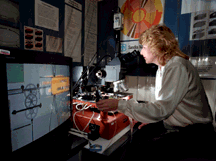Tiny ‘Micro Guardian’ promises to safeguard nuclear weapons in big way
One of the most complicated micro-systems Sandia has ever built, the "Micro Guardian" trajectory safety subsystem, will be tested in the next few weeks for the first time after more than a year of research and development.

Download 150dpi JPEG image, ‘potts_pix.jpg’, 1 Mb
The trajectory safety subsystem is the portion of a nuclear weapon that ensures it doesn’t detonate unless a series of events occur that indicate triggering action is appropriate. Sandia’s Micro Guardian — the world’s smallest trajectory system — will fit on the tip of a pencil eraser and incorporate several micromachines, microelectronics, and micro-optics on one chip. It will eventually be part of a micro-firing system the size of a stack of three quarters.
Beth Potts (2168), project leader, says that during the initial tests, scheduled for next month and then later this year, the device won’t be as small or have all the components planned for the final version. "However, " she notes, "we are on a path of discovery, innovation, and good engineering that will lead us to the Micro Guardian we envision."
Working with Beth on the project is a team from Centers 1700, 2100, and 2600.
David Plummer, Manager of Electromechanical Engineering Dept. 2643, and Jim Smith, Manager of Intelligent Micromachine Dept. 1725, first came up with the idea of a miniature trajectory-sensing device using microelectromechanical systems (MEMS) technology about a year ago. Kent Meeks, Manager of Advanced Weapons Technologies Dept. 2168, immediately expanded the scope from just a component to an entire safety subsystem.
"Current efforts provide the first steps toward achieving a highly integrated, mixed-technology micro-system that Sandia is uniquely positioned to develop," Kent says. "No one else in the world has capabilities to combine sophisticated micro-optics, microelectronics, and micro-devices into a single integrated micro-system."
David says that the new subsystem "has its roots in the past" and will be replacing older technologies, some dating back to the 1970s.
"Many of the concepts in the new trajectory safety subsystem are direct analogs of macro-sized devices developed years ago," David says. "The advances in microfabrication technologies developed in 1700 allow us to replace devices that combined are about the size of two Tom Clancy paperbacks into something smaller than a dime."
Cheaper, smaller than older systems
This new, smaller trajectory subsystem will be cheaper to build than older systems and will free up space in the nuclear weapons to allow other safety improvements. The cost savings will be enabled through the lower cost batch processing techniques employed in microfabrication.
The Micro Guardian, which will be about 10 by 6 by 5 millimeters when completed, will be part of an advanced optically powered micro-firing system being developed by Dept. 2674. The miniature sentry that guards the door will interrupt the optical energy supplied to the firing system.
In the new trajectory scheme, light flows through an optical fiber into a locked chamber where it bounces around, doing nothing to power the weapon. Only when a unique flight acceleration environment is sensed — as when the system is flying toward its destination — the light energy is redirected by a movable mirror to a photocell, which provides the necessary energy to charge the micro firing set. Detonation can occur only after the weapon has experienced the proper safety-enabling environments.
The subsystem consists of two major elements, the Smart ESD (environmental sensing device) and the Micro Optical Stronglink, both fabricated in the Microelectronics Development Laboratory (MDL) using Sandia’s multilevel polysilicon MEMS process. MEMS device
The MEMS ESD, developed by Marc Polosky (2643), contains embedded codes and consists of a suspended shuttle — a moving piece of polysilicon slightly larger than the tip of a mechanical pencil. When the device senses acceleration of sufficient magnitude, the suspended shuttle moves, passing underneath a Photonic Integrated Circuit (PIC) that reads the codes. The PIC, designed by Charles Sullivan (1713) in the Compound Semiconductor Research Lab, is positioned above the ESD, and through a back scattering measurement technique, interrogates the code channels as the shuttle moves past the PIC.
Connected to the PIC is an ASIC (application specific integrated circuit), designed by Dale Kemper (1736). The ASIC accepts the information from the PIC and converts it into the drive signals necessary to drive a Micro Optical Stronglink — a MEMS mechanical locking mechanism consisting of two coded wheels that prevents optical energy from entering the area with the moveable mirror until receiving a 24-event code.
The coded signal created by the ASIC is only five volts, compared to the 90 volts needed to drive the micro-stronglink. An intermediate small circuit developed by Fred Anderson (2674) amplifies the coded signal.
Once the correct code is received, the stronglink unlocks the moveable mirror, which is then oriented into proper alignment to redirect optical energy to the photocell, enabling the micro firing set to charge. If the wrong code is received, the stronglink irrevocably locks up.
Beth says that a number of others helped pull the project together. Most noteworthy are Cathy Reber (1726) and her team, who are developing packaging for the device, and Joe Perry (2691), who developed a tester required to demonstrate the hardware. Integration of the complex optical interfaces for the micro-system is led by Scott Holswade (2674) and his team.
Michael Callahan, Senior Manager of Program Management Dept. 2402, says the project provides "a significant marriage of emerging research with future weapon needs."
"Micro-Guardian is bringing together various micro-system technologies that when integrated will enable a whole new class of future micro-systems that haven’t yet been imagined," Michael says.